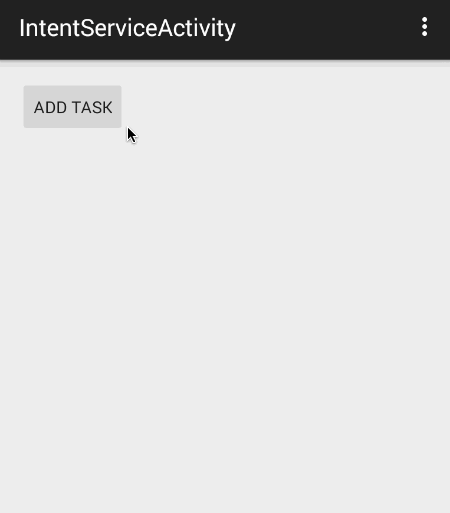Android IntentService完全解析 當Service遇到Handler
轉載請標明出處:
http://blog.csdn.net/lmj623565791/article/details/47143563;
本文出自:【張鴻洋的部落格】
一 概述
大家都清楚,在Android的開發中,凡是遇到耗時的操作儘可能的會交給Service去做,比如我們上傳多張圖,上傳的過程使用者可能將應用置於後臺,然後幹別的去了,我們的Activity就很可能會被殺死,所以可以考慮將上傳操作交給Service去做,如果擔心Service被殺,還能通過設定startForeground(int, Notification)方法提升其優先順序。
那麼,在Service裡面我們肯定不能直接進行耗時操作,一般都需要去開啟子執行緒去做一些事情,自己去管理Service的生命週期以及子執行緒並非是個優雅的做法;好在Android給我們提供了一個類,叫做IntentService,我們看下注釋。
IntentService is a base class for {@link Service}s that handle asynchronous
requests (expressed as {@link Intent}s) on demand. Clients send requests
through {@link android.content.Context#startService(Intent)} calls; the
service is started as needed, handles each Intent in turn using a worker
thread, and stops itself when it runs out of work.
意思說IntentService是一個基於Service的一個類,用來處理非同步的請求。你可以通過startService(Intent)來提交請求,該Service會在需要的時候建立,當完成所有的任務以後自己關閉,且請求是在工作執行緒處理的。
這麼說,我們使用了IntentService最起碼有兩個好處,一方面不需要自己去new Thread了;另一方面不需要考慮在什麼時候關閉該Service了。
好了,那麼接下來我們就來看一個完整的例子。
二 IntentService的使用
我們就來演示一個多個圖片上傳的案例,當然我們會模擬上傳的耗時,畢竟我們的重心在IntentService的使用和原始碼解析上。
首先看下效果圖
效果圖
每當我們點選一次按鈕,會將一個任務交給後臺的Service去處理,後臺的Service每處理完成一個請求就會反饋給Activity,然後Activity去更新UI。當所有的任務完成的時候,後臺的Service會退出,不會佔據任何記憶體。
Service
package com.zhy.blogcodes.intentservice;
import android.app.IntentService;
import android.content.Context;
import android.content.Intent;
import android.util.Log;
public class UploadImgService extends IntentService
{
private static final String ACTION_UPLOAD_IMG = "com.zhy.blogcodes.intentservice.action.UPLOAD_IMAGE";
public static final String EXTRA_IMG_PATH = "com.zhy.blogcodes.intentservice.extra.IMG_PATH";
public static void startUploadImg(Context context, String path)
{
Intent intent = new Intent(context, UploadImgService.class);
intent.setAction(ACTION_UPLOAD_IMG);
intent.putExtra(EXTRA_IMG_PATH, path);
context.startService(intent);
}
public UploadImgService()
{
super("UploadImgService");
}
@Override
protected void onHandleIntent(Intent intent)
{
if (intent != null)
{
final String action = intent.getAction();
if (ACTION_UPLOAD_IMG.equals(action))
{
final String path = intent.getStringExtra(EXTRA_IMG_PATH);
handleUploadImg(path);
}
}
}
private void handleUploadImg(String path)
{
try
{
//模擬上傳耗時
Thread.sleep(3000);
Intent intent = new Intent(IntentServiceActivity.UPLOAD_RESULT);
intent.putExtra(EXTRA_IMG_PATH, path);
sendBroadcast(intent);
} catch (InterruptedException e)
{
e.printStackTrace();
}
}
@Override
public void onCreate()
{
super.onCreate();
Log.e("TAG","onCreate");
}
@Override
public void onDestroy()
{
super.onDestroy();
Log.e("TAG","onDestroy");
}
}程式碼很短,主要就是繼承IntentService,然後複寫onHandleIntent方法,根據傳入的intent來選擇具體的操作。startUploadImg是我寫的一個輔助方法,省的每次都去構建Intent,startService了。
Activity
package com.zhy.blogcodes.intentservice;
import android.content.BroadcastReceiver;
import android.content.Context;
import android.content.Intent;
import android.content.IntentFilter;
import android.os.Bundle;
import android.support.v7.app.AppCompatActivity;
import android.view.Menu;
import android.view.MenuItem;
import android.view.View;
import android.widget.LinearLayout;
import android.widget.TextView;
import com.zhy.blogcodes.R;
public class IntentServiceActivity extends AppCompatActivity
{
public static final String UPLOAD_RESULT = "com.zhy.blogcodes.intentservice.UPLOAD_RESULT";
private LinearLayout mLyTaskContainer;
private BroadcastReceiver uploadImgReceiver = new BroadcastReceiver()
{
@Override
public void onReceive(Context context, Intent intent)
{
if (intent.getAction() == UPLOAD_RESULT)
{
String path = intent.getStringExtra(UploadImgService.EXTRA_IMG_PATH);
handleResult(path);
}
}
};
private void handleResult(String path)
{
TextView tv = (TextView) mLyTaskContainer.findViewWithTag(path);
tv.setText(path + " upload success ~~~ ");
}
@Override
protected void onCreate(Bundle savedInstanceState)
{
super.onCreate(savedInstanceState);
setContentView(R.layout.activity_intent_service);
mLyTaskContainer = (LinearLayout) findViewById(R.id.id_ll_taskcontainer);
registerReceiver();
}
private void registerReceiver()
{
IntentFilter filter = new IntentFilter();
filter.addAction(UPLOAD_RESULT);
registerReceiver(uploadImgReceiver, filter);
}
int i = 0;
public void addTask(View view)
{
//模擬路徑
String path = "/sdcard/imgs/" + (++i) + ".png";
UploadImgService.startUploadImg(this, path);
TextView tv = new TextView(this);
mLyTaskContainer.addView(tv);
tv.setText(path + " is uploading ...");
tv.setTag(path);
}
@Override
protected void onDestroy()
{
super.onDestroy();
unregisterReceiver(uploadImgReceiver);
}
}Activity中,每當我點選一次按鈕呼叫addTask,就回模擬建立一個任務,然後交給IntentService去處理。
注意,當Service的每個任務完成的時候,會傳送一個廣播,我們在Activity的onCreate和onDestroy裡面分別註冊和解註冊了廣播;當收到廣播則更新指定的UI。
佈局檔案
<LinearLayout android:id="@+id/id_ll_taskcontainer"
xmlns:android="http://schemas.android.com/apk/res/android"
xmlns:tools="http://schemas.android.com/tools"
android:layout_width="match_parent"
android:layout_height="match_parent"
android:orientation="vertical"
>
<Button android:layout_width="wrap_content" android:layout_height="wrap_content"
android:onClick="addTask" android:text="add Task"/>
</LinearLayout>ok,這樣我們就完成了我們的效果圖的需求;通過上例,大家可以看到我們可以使用IntentService非常方便的處理後臺任務,遮蔽了諸多細節;而Service與Activity通訊呢,我們選擇了廣播的方式(當然這裡也可以使用LocalBroadcastManager)。
學會了使用之後,我們再一鼓作氣的看看其內部的實現。
三 IntentService原始碼解析
直接看IntentService原始碼
/*
* Copyright (C) 2008 The Android Open Source Project
*
* Licensed under the Apache License, Version 2.0 (the "License");
* you may not use this file except in compliance with the License.
* You may obtain a copy of the License at
*
* http://www.apache.org/licenses/LICENSE-2.0
*
* Unless required by applicable law or agreed to in writing, software
* distributed under the License is distributed on an "AS IS" BASIS,
* WITHOUT WARRANTIES OR CONDITIONS OF ANY KIND, either express or implied.
* See the License for the specific language governing permissions and
* limitations under the License.
*/
package android.app;
import android.content.Intent;
import android.os.Handler;
import android.os.HandlerThread;
import android.os.IBinder;
import android.os.Looper;
import android.os.Message;
public abstract class IntentService extends Service {
private volatile Looper mServiceLooper;
private volatile ServiceHandler mServiceHandler;
private String mName;
private boolean mRedelivery;
private final class ServiceHandler extends Handler {
public ServiceHandler(Looper looper) {
super(looper);
}
@Override
public void handleMessage(Message msg) {
onHandleIntent((Intent)msg.obj);
stopSelf(msg.arg1);
}
}
public IntentService(String name) {
super();
mName = name;
}
public void setIntentRedelivery(boolean enabled) {
mRedelivery = enabled;
}
@Override
public void onCreate() {
super.onCreate();
HandlerThread thread = new HandlerThread("IntentService[" + mName + "]");
thread.start();
mServiceLooper = thread.getLooper();
mServiceHandler = new ServiceHandler(mServiceLooper);
}
@Override
public void onStart(Intent intent, int startId) {
Message msg = mServiceHandler.obtainMessage();
msg.arg1 = startId;
msg.obj = intent;
mServiceHandler.sendMessage(msg);
}
@Override
public int onStartCommand(Intent intent, int flags, int startId) {
onStart(intent, startId);
return mRedelivery ? START_REDELIVER_INTENT : START_NOT_STICKY;
}
@Override
public void onDestroy() {
mServiceLooper.quit();
}
@Override
public IBinder onBind(Intent intent) {
return null;
}
protected abstract void onHandleIntent(Intent intent);
}可以看到它在onCreate裡面初始化了一個HandlerThread,關於HandlerThread的使用和原始碼
分析參考:Android HandlerThread 完全解析,看到這估計已經能猜到它的邏輯了:
就是每次呼叫onStartCommand的時候,通過mServiceHandler傳送一個訊息,訊息中包含我們的intent。然後在該mServiceHandler的handleMessage中去回撥onHandleIntent(intent);就可以了。
那麼我們具體看一下原始碼,果然是這樣,onStartCommand中回撥了onStart,onStart中通過mServiceHandler傳送訊息到該handler的handleMessage中去。最後handleMessage中回撥onHandleIntent(intent)。
注意下:回撥完成後回撥用 stopSelf(msg.arg1),注意這個msg.arg1是個int值,相當於一個請求的唯一標識。每傳送一個請求,會生成一個唯一的標識,然後將請求放入佇列,當全部執行完成(最後一個請求也就相當於getLastStartId == startId),或者當前傳送的標識是最近發出的那一個(getLastStartId == startId),則會銷燬我們的Service.
如果傳入的是-1則直接銷燬。
那麼,當任務完成銷燬Service回撥onDestory,可以看到在onDestroy中釋放了我們的Looper:mServiceLooper.quit()。
ok~ 如果你的需求可以使用IntentService來做,可以儘可能的使用,設計的還是相當讚的。當然了,如果你需要考慮併發等等需求,那麼可能需要自己去擴充套件建立執行緒池等。
ok~~
相關文章
- Android Service完全解析Android
- Android Https相關完全解析 當OkHttp遇到HttpsAndroidHTTP
- Handler訊息機制完全解析Handler解析
- Android IntentService 的使用和解析AndroidIntent
- Android四大元件之Service,以及IntentServiceAndroid元件Intent
- Android Service和IntentService知識點詳細總結AndroidIntent
- Android Handler 原始碼解析Android原始碼
- Android中IntentService的使用及其原始碼解析AndroidIntent原始碼
- Android IntentServiceAndroidIntent
- Android 8.1 Handler 原始碼解析Android原始碼
- Android IntentService使用全面介紹及原始碼解析AndroidIntent原始碼
- 用IntentService 與ResultReceiver連線web serviceIntentWeb
- Android 使用IntentServiceAndroidIntent
- 【Android自助餐】Handler訊息機制完全解析(二)MessageQueue的佇列管理Android佇列
- Handler解析
- Android Service完全解析,關於服務你所需知道的一切(上)Android
- Android的Handler訊息機制 解析Android
- Android IntentService 工作原理AndroidIntent
- Android Service最全面的解析Android
- Android ToolBar 使用完全解析Android
- Android感測器完全解析Android
- Android DiskLruCache快取完全解析Android快取
- Android面試相關 - IntentServiceAndroid面試Intent
- Android原始碼解析Handler系列第(四)篇 --- 打破Handler那些困惑事兒Android原始碼
- HandlerThread和IntentService原始碼解析threadIntent原始碼
- Android Fragment 真正的完全解析(上)AndroidFragment
- Android 9.0 原始碼_機制篇 -- 全面解析 HandlerAndroid原始碼
- Handler全家桶之 —— Handler 原始碼解析原始碼
- Android中IntentService原始碼分析AndroidIntent原始碼
- [Handler]android-Handler解釋Android
- Android中元件生命週期完全解析Android元件
- Android View 佈局流程(Layout)完全解析AndroidView
- Android View 繪製流程(Draw) 完全解析AndroidView
- Android跨程式元件IPCInvoker用法完全解析Android元件
- Handler機制解析
- Handler原始碼解析原始碼
- Android Service重啟恢復(Service程式重啟)原理解析Android
- Android多執行緒基礎 解析Handler機制Android執行緒
